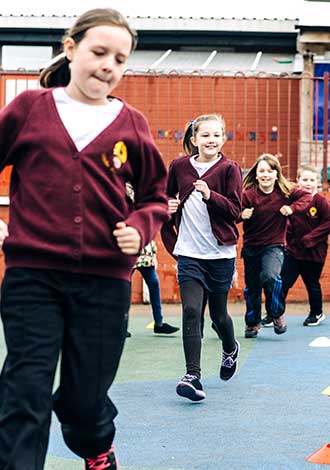Keeping children active during the school day is challenging enough, without the disruption we’ve all experienced in 2020. 
During the lockdown period widespread closure of schools, leisure centres, gyms, pitches and courts, meant that parents not only had to take on homeschooling but thinking imaginatively about how to keep children active - often amidst time restrictions and limited access to outdoor space.
Sport England’s July report on ‘Children’s experience of physical activity in lockdown’ highlighted a number of changes to how children were keeping active, over the lockdown period:
- 93% children are doing something to stay active but activity levels have fallen with just 19% of under 16’s doing at least an hour of physical activity each day, this compares to 46.8% prior to Covid.
- 43% are doing less than 30 minutes a day compared to 29% before coronavirus hit.
- It was promising to note that girls, who typically are less active than boys, are seeing a positive impact on activity levels during lockdown with 16% saying they are more active during lockdown compared to 11% of boys. This is even more noticeable when looking at the gender gap for those doing less activity during lockdown with just over a quarter (26%) of girls doing less compared to nearly four in ten (37%) boys.
- The most commonly cited for changes in activity levels is the lack of access to their usual spaces, concerns around covid-19 or school closures. More than a third stated that the change in activity levels was due to their usual clubs, leisure centres, gyms or classes being closed and almost a quarter due to their local playground, skate park, pitch or court being closed.
- Not attending school has hugely impacted activity levels with 36% highlighting this as a reason for their changing activity levels, whilst one in five of those who are doing no form of physical activity stated that not going to school has reduced opportunities to be active.
- Walking has become an incredibly popular activity during lockdown, 71% of children reported going for a walk, with this substituting many of the usual activity types for children; more than double the amount of children went for a walk in the past week than did outside of lockdown according to Active Lives. The only other activity that has been more prevalent during lockdown than before has been bike and scooter rides.
Although this may not, perhaps, be surprising, the impact of the lockdown period on active play was significant:
- Normally active play is the top activity for primary age children with 72% taking part and second amongst secondary age children with 49% taking part.
- During this the first lockdown figures dropped to 59% and 32% for years 3-6 and years 7-11 respectively.
- Those with access to outdoor space are more likely to have done an hour of exercise a day, 20%, whilst only 13% of those without access to outdoor space achieved the recommended hour a day.
- Nearly four in ten children from a BAME background undertook exercise indoors compared to a quarter of those from a White background.
With a widespread return to school in September, however, social distancing has presented challenges for those wanting to incorporate outdoor activities into the school day. This has been recognised as a significant challenge, resulting in the Department for Education launching a new online video collection to support young people’s mental and physical health. From Wednesday 23 September, schools have been able to access videos on YouTube which provide creative and entertaining content that helps staff to safely offer 30 active minutes in a Covid-secure environment. This includes videos from schools and young leaders across the country sharing best practice on how to incorporate being active into lessons, break-times and travel times, content from Sport England featuring their Daily Activators doing the ‘Daily Mile’, inclusive activities for pupils with Special Educational Needs and Disabilities (SEND) and content to encourage more girls to get involved in physical activity.
This followed the Education Secretary’s announcement in the summer that schools in England will benefit from £320 million from the PE and Sport Premium during this academic year underlining the importance of PE and sport in the Government’s manifesto. The PE and Sport Premium is designed to help children get an active start in life, supporting primary schools to improve the quality of their PE and sport provision so that pupils experience the benefits of regular exercise – from becoming healthier both mentally and physically to improved behaviour and better academic achievement.
Youth Sport Trust Chief Executive Ali Oliver said:
“Young people are returning to schools with low levels of physical fitness and poor mental health while social distancing guidelines are presenting new challenges to the delivery of PE and school sports.
“Schools have been working creatively to ensure young people access daily physical activity, weekly Physical Education and after-school sport. However, we know that many are lacking confidence.”
Tim Hollingsworth, CEO, Sport England said:
“We have a significant opportunity with schools now back to help get our children and young people active again, and there is clear evidence that it can help their attainment at school and contribute to their health and happiness.”
Public Health Minister Jo Churchill said:
“Giving children and young people the opportunity to exercise during the school day is the perfect way for them to have fun and be active with their friends. Exercise when combined with a healthy balanced diet is the perfect recipe to stay fit and healthy both physically and mentally and have fun too.”
As the term draws to a close, however, it will be interesting to look back at 2020 as a whole, to understand the impact a lack of structured exercise and, in particular, active play has had on children’s fitness and wellbeing - not just in terms of the types of statistics included in this article but
the impact on the wider benefits we know outdoor, active play brings. During our own research we have found that active play has a demonstrably positive effect on behaviour, attitude to learning, physical literacy, wellbeing, happiness and social skills. As things stand there is little insight into the full effect that 2020’s disrupted school time has had.
In a bid to address this lack of understanding we’re delighted to announce that we’re starting 2021
as we mean to go on with a programme of weekly polls and focus groups - all delivered digitally.
Our first topic, in January, will be looking at combatting obesity in the time of COVID-19. Those of you that have worked with us for a number of years will remember our 2015, 2016 and 2017 white papers, surveys and research into the ways schools were working to combat childhood obesity through outdoor learning.
You can read more about these and download them here.
But with outdoor time and school activities restricted throughout 2020 we want to find out how this has affected children and staff, as well as the steps being taken to change the way things are done and to keep children active outdoors.
We’ll be hosting a Zoom-based focus group on Tuesday 26th January. An independent moderator will talk to representatives from schools across the country, asking them about their approach to combatting obesity in the time of COVID-19. The session will last 60minutes and attendees will be entered into a prize draw to win £200 voucher to spend in the
Playforce shop on the Ready to Play range.